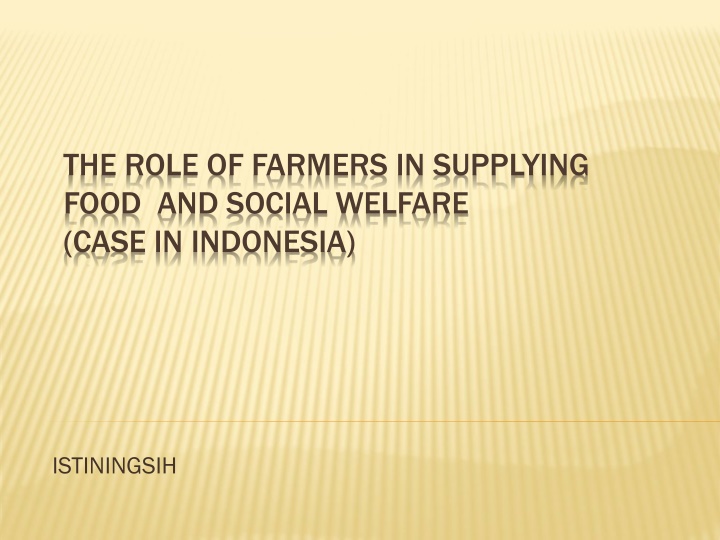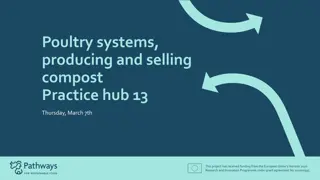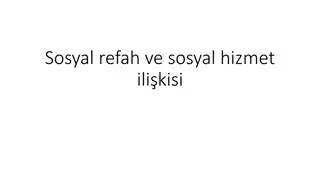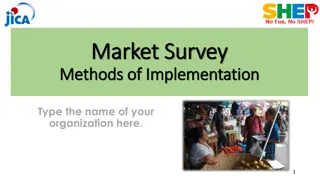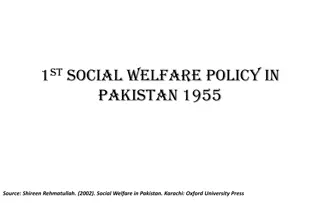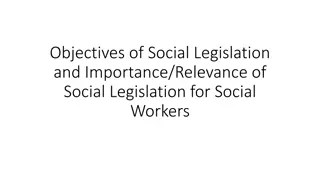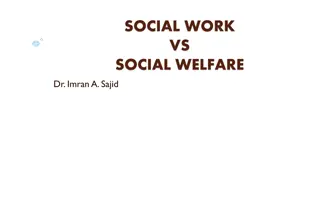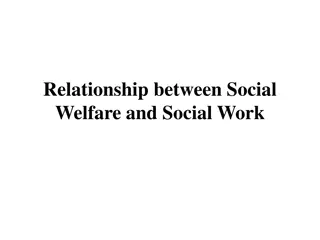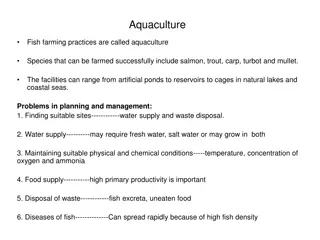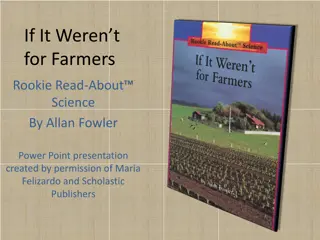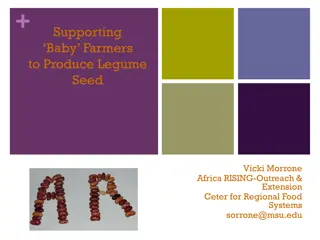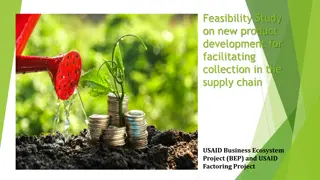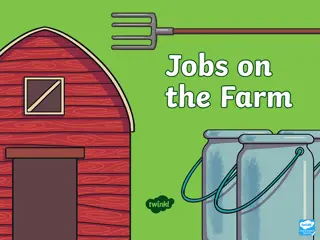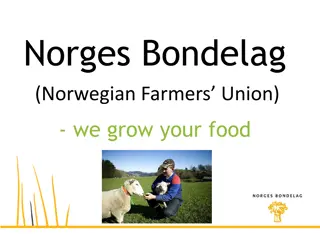The Essential Role of Farmers in Indonesia's Food Supply and Social Welfare
Farmers play a crucial role in supplying food to Indonesia's growing population and contributing to social welfare. This article explores the intersection of food production, population growth, and social welfare in Indonesia, emphasizing the significance of farmers in ensuring food security and societal well-being.
Download Presentation

Please find below an Image/Link to download the presentation.
The content on the website is provided AS IS for your information and personal use only. It may not be sold, licensed, or shared on other websites without obtaining consent from the author.If you encounter any issues during the download, it is possible that the publisher has removed the file from their server.
You are allowed to download the files provided on this website for personal or commercial use, subject to the condition that they are used lawfully. All files are the property of their respective owners.
The content on the website is provided AS IS for your information and personal use only. It may not be sold, licensed, or shared on other websites without obtaining consent from the author.
E N D
Presentation Transcript
THE ROLE OF FARMERS IN SUPPLYING FOOD AND SOCIAL WELFARE (CASE IN INDONESIA) ISTININGSIH
INTRODUCTION WHY FARMERS? WHY FOOD? Food is a mojor requirement of human being. When Indonesian people can not produce enough food, how is the fate of the population? The total amount of Indonesian population always increases every year. Will Indonesia people always import food from other countries? WHY SOCIAL WELFARE? In this section will be discussed the relationship between farmers and social welfare.
POPULATION INCREASE IN INDONESIA 3 3 Millions Millions/ /Year 2015 2015 - - 254,9 Millions 254,9 Millions 2035 2035 305,6 Millions 305,6 Millions Year
SOCIAL WELFARE Social welfare is the condition which is the fulfill of humans need such like material, spiritual, and social for proper life to do the social function. In Indonesia, there are some groups of farmers. There are very dinamic interaction among them. Governmental and nongovernmental organizations can take benefit from farmer s groups for various interests.
INDONESIA Indonesia region tataled Indonesia region tataled 5.193.252 km2 mainland and mainland and 3.302.498 km2 3.302.498 km2 sea. Based on natural potential, Indonesia is agricultural country. Indonesia is agricultural country. The agriculture covers livestock, crops, fisheryies. The agriculture covers livestock, crops, fisheryies. 5.193.252 km2 , consist of sea. Based on natural potential, , consist of 1.890.754 km2 1.890.754 km2
AGRICULTURE IN INDONESIA - CROP Producers of grain, no. 6 in the world Rice, no. 3 after China and India Coffee, no. 4 Chocolate, no 2 White pepper, no. 3 Rubber, nomor 4 Clove, 1 Palm oil, no 2
Import: Rice, Sugar, Soy, wheat. Corn, Beef, Milk powder. Prosessed food, Cassava, and Peanuts.
KEGIATAN UPAYA KHUSUS (UPSUS) PERCEPATAN SWASEMBADA PADI, JAGUNG, DAN KEDELAI (RENCANA TAHUN 2015-2019) Rehabilitasi Jaringan irigasi tersier Percepatan Optimasi Lahan Bantuan Benih Bantuan Pupuk Bantuan Alsintan Pendampingan Penyuluh 17 17
PLAN AND POLICY OF MINISTRY OF AGRICULTURE IN INDONESIA 2015 - 2019 Kementerian Pertanian www.pertanian.go.id 18 18 18
REALIZE ECONOMIC INDEPENDENCE BY MOVING THE STRATEGIC SECTORS OF THE DOMESTIC ECONOMY Enhancement Enhancement The Food sovereignty is reflected on the power on independently regulate food problems. The concrete reflections are: 1. Enough Food supplies for Indonesian people which are produced by domestic farmers. 2. The Policy of food that is made by Ministry of Agriculture must not be interveted by other country. 3. The power of government in protecting the farmers. 4. The power of government in order to make prosperous to farmers The Sovereignty Sovereignty of of Food Food. . 19
DUKUNGAN SINERGI LINTAS SEKTOR UNTUK PENCAPAIAN SWASEMBADA PADI, JAGUNG & KEDELAI MELALUI PERBAIKAN JARINGAN IRIGASI Revitalisasi jaringan irigasi primer dan sekunder Sinergi pemahaman program produksi (perluasan lahan, budidaya, pascapanen, dan konsumsi) Akurasi data KEMEN. KEMEN. P U P U BPS PT SHS, PT PT SHS, PT PERTANI, PERTANI, PENANGKAR PENANGKAR Penyediaan benih unggul padi, jagung dan kedelai PUPUK INDONESIA HOLDING COMPANY (PIHC) KEMEN PERINDUS TRIAN KEMENTERIA KEMENTERIA N N PERTANIAN PERTANIAN Revitalisasi penggilingan padi, penguatan industri pakan Penyediaan pupuk Penyerapan produksi kedelai untuk tahu dan tempe KOPTI KEMENDAG Penetapan harga dan kelancaran distribusi beras jagung dan kedelai Pengaturan importasi sapi bakalan dan daging BULOG Penyediaan beras dalam negeri 20
SYNERGISTIC SUPPORTING FROM OTHER SECTORS FOR THE ACHIEVMENT OF FOOD SELF SUFFICIENCY OF RICE, CORN, SOY Revitalization of irrigation Understanding of the production program (expansion of land, cultivation, post- harvest, consumption) Accuracy of datas MINISTRY MINISTRY OF PUBLIC OF PUBLIC WORK WORK CENTRAL BEUREU OF STATISTICS (bps) Supplying seeds LIMITED LIABILITY LIMITED LIABILITY COMPANY: (pertani, COMPANY: (pertani, penangkar) penangkar) PUPUK INDONESIA HOLDING COMPANY (PIHC) MINISTRY OF INDUSTRY MINISTRY OF MINISTRY OF AGRICULTURE AGRICULTURE Revitalization of Rice Mill Fertilizer Supply MINISTRY OF TRADE Production Apsorbtion KOPTI Price fixing Regulation of import BULOG Rice Supply from Indonesia 21
The Goals of Food Sovereignty 1. The increase of food supply from Indonesian farmers: Rice Soy Corn Beef Sugar 2. The increase of Distribution of food: Controlling of food distribution Developing of logistic system 3. The increase of food quality 4. Irrigation infrastucture is available: Irrigation networking Rehabilition for networking New building of reservoir 22
PROBLEM Farming system is still traditional and conventional. Farming technology has not been modern yet. It makes young people are not interested in farming Agriculture is assumed as dirty, hot, rough, not pretentious. Farmer: traditional mind set, high resistency to change into modern system. Petani: Mind set tradisional, konvensional. 62% of farmers is above 55 years old, young farmers are only 12% (data January 2016) In villages, most young people like working for companies, department stores, hotels, restaurant, offices. The emplyess at farming sector is less and less . It causes the cost for farming production to increase. Value added / Rate of Return iwill be lower. It means Indonesia farmers are still poor.
Most of parents do not want that their children will be farmers. Alignment The trend of government in protecting the products of farming is still weak. Such as: Harvest is bought by traders. There is no price standar. Most young people of Indonesian are not interested in Agriculture education , especilly in studying formal education. There is only a few agriculture education for high school students. The department of vocational schools such as automatic, hotels, IT, are more interesting. Agriculture scientists are less and less. There are only a few innovative agriculture scientist in Indonesia.
Agriculture sector is the last choice of young people in finding the job. Farmers are not serious in doing their farming work. It is becaused their primary works are in other sector. In this case, the result of farming job is not iptimal. Government policy is not supporting: the price of fertilizer, sed, pestizide and so on. Organic system of agriculture (that is environmentally friendly) is not fully implemented. There is only a little of agriculture industrialization.
RECOMMENDATION Giving appreciation to students who wants to study at agriculture departement Government provides some more modern equipment to school laboratory Government provides some more modern equipmnet to farmers Subsidy is increased to farmers. The budget of agriculture sector should be increased, such like Education Ministry is until 20% from total budget of Indonesian income. Empowerement to farmers is increased through Agriculture extension.
The assistance to farmers is one of programs that is designed by ministry of agriculture. The approach of the assistance is group model. Group approach has some benefits. The benefits are: means of communication among farmers, build togetherness, take and give, help each other, etc. The groups of farmer are function as conflict resolution.
Problem solving MUTUAL COOPERATION Asssitance from Agriculture Extension Worker
STEPS OF CONFLICT RESOLUTION Informal conflict resolution that is done by others Conflict resolution that is done by one who has authority Informal problem solving that is done by themselves Conflict resolution that is done by law regulation Compulsion To avoid the conflicts Negotiation There is a little bit of compulsion
